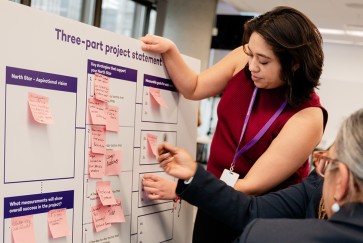We don’t yet know the long-term impact on someone’s lungs when they vape. Or if the air quality where a person grows up puts them at higher risk for respiratory conditions later in life. These issues, and much more, will be examined in a large, first-of-its-kind longitudinal study of lung health led by Northwestern Medicine scientists in partnership with the American Lung Association.
First federally funded U.S. community-based cohort study of millennials
The study, titled “The American Lung Association Lung Health Cohort,” is funded by a $24.8 million grant awarded June 16 by the National Heart, Lung, and Blood Institute (NHLBI), part of the National Institutes of Health (NIH).
In this first federally funded U.S. cohort to study millennials, scientists will capture baseline lung health measurements of 4,000 healthy adults between the ages of 25 to 35 to identify an ideal picture of respiratory health and understand the key risk factors and biomarkers that are associated with impaired lung health.
“We’ve never taken a life-course view of how someone transitions from ideal respiratory health to impaired health to actual lung disease,” said principal investigator Dr. Ravi Kalhan, professor of medicine and preventive medicine at Northwestern University Feinberg School of Medicine and a Northwestern Medicine pulmonologist. “We want to come up with a framework to intercept chronic lung disease before it becomes a problem.”
Findings from the study will arm doctors with information to recognize respiratory problems early and intervene before patients develop chronic lung disease, the fourth-leading cause of death. The long-term goal of the study aims to identify who is at risk for developing chronic lung diseases such as chronic obstructive pulmonary disease(COPD), emphysema and pulmonary fibrosis.
“This study of a millennial cohort is the first NHLBI-funded program that plans to look at factors influencing lung health through adulthood,” said James Kiley, director of the NHLBI Division of Lung Diseases. “It has the potential to critically inform the way we think about how lung health varies between individuals and changes as we age.”
Finding the equivalent of ‘cholesterol’ for the lung
It’s commonly accepted that high blood pressure and high cholesterol lead to cardiovascular disease, thanks to large longitudinal studies examining heart health. But lung health hasn’t benefited from this same level of research attention. This study will change that. It is the first federally funded community-based cohort study to focus on lung health.
“Primary care doctors can prevent heart attacks by proactively checking patients’ cholesterol levels, but we don’t do anything similar for respiratory disease,” Kalhan said. “We wait until it becomes a problem and then try to treat it. We hope this study helps us find the equivalent of ‘cholesterol’ for the lung.”
Some study participants will be smokers and some will not. Some will live in cities and others will live in suburban or rural areas. The aim is to recruit a wide range of healthy adults.
“By recruiting men and women from across the nation, we hope our findings ultimately will be relevant to the millions of adults in this generation,” said Mercedes Carnethon, chief of epidemiology in the department of preventive medicine at Feinberg.
The scientists will leverage the national infrastructure of the American Lung Association’s Airways Clinical Research Centers (ACRC) to recruit study participants from its 17 metropolitan centers across the U.S. Chicago is one of those centers.
Scientists will follow these individuals for six years after their initial interviews to track how their environment, lifestyle and physical activity habits affect their respiratory health. The goal is to renew the grant so the scientists can continue to follow the study participants for the rest of their lives.
Determining environmental, e-cigarette, other risk factors
Participants will be measured on their exposure to smoking, drinking and vaping; have a nutritional assessment; wear physical activity monitors and self-report symptoms such as fatigue and sleep disturbances.
The scientists will ask study participants where they lived at key times in their life (e.g. when they were born, started kindergarten, high school, etc.) and use satellite modeling that measures airborne particulates to determine an environmental measurement of their life-course exposure from birth to adulthood.
While the risks of smoking cigarettes has been well documented in epidemiological studies, vaping is a relatively new and understudied trend.
“It’s conceivable that someone who vapes a lot between the ages of 16 and 30, even if they stop, might have a lifetime of potential problems, but we just don’t know what those are,” Kalhan said.
Important to study younger generations
Lung health is believed to reach its peak when a person is between 25 and 35 years old, Kalhan said. By getting a baseline measurement of people in this age range, researchers will be able to identify the exposures and biomarkers that are associated with susceptibly of getting lung disease versus studying people in their 50s and 60s, which is when lung disease symptoms typically surface.
“The future health of the nation is predicated not on just studying baby boomers,” Carnethon said. “We need to study newer generations, current exposures and current risk factors. Everything that was relevant in 1978 is not necessarily relative to today.”
The scientists will request zip codes of where study participants lived in their childhood and teenage years to retroactively track their environmental exposure over their lifetime. Geocoding is currently used in studies but this will be the first time it is used to retroactively track data across an individual’s life-to-date to determine how their environment from birth to young adulthood influences lung health in adult life.
How often have you had bronchitis this year?
Participants will be asked how often they’ve had bronchitis that year and if they were born at full term or early, as premature birth is likely associated with impaired respiratory health, Kalhan said.
“A lot of people go to urgent care for bronchitis, and no one makes a big deal of that, but people who have respiratory symptoms are at increased risk of getting emphysema,” Kalhan said. “It’s not normal to have bronchitis three times a year.”
To track lung health, a person will blow into a breathing machine to see how much air they can produce. While this process indicates when someone has very abnormal results, it lacks the nuance needed to identify small abnormalities in a person’s breathing. This study will uselow-dose CT scans to track intermediate stages of lung injury and abnormalities in the windpipes.
“Why wait around for someone to blow into the machine and have it be grossly abnormal when we could be taking measures to attack their impaired lung health at the onset?” Kalhan said.
“In so many ways, the respiratory system is on the front lines of our health, yet much more research is needed to truly understand how environmental exposures and behaviors impact lung health throughout life,” said American Lung Association President and CEO Harold Wimmer. “This first-of-its-kind study will engage the broader scientific community in an effort to understand respiratory disease, and will serve as a pivotal step forward for the lung health and lives of all Americans. The Lung Association is proud that our Airways Clinical Research Centers Network serves as an integral part of this important work.”
Northwestern is the primary recipient of the NIH grant but scientists from Johns Hopkins Medicine, Brigham and Women’s Hospital, University of Michigan, University of Alabama-Birmingham, Beth Israel Deaconess Medical Center and more also will be collaborating on the research along with other institutions from the ACRC.
Funding for this award will be provided by NIH grant 1U01HL146408-01.


